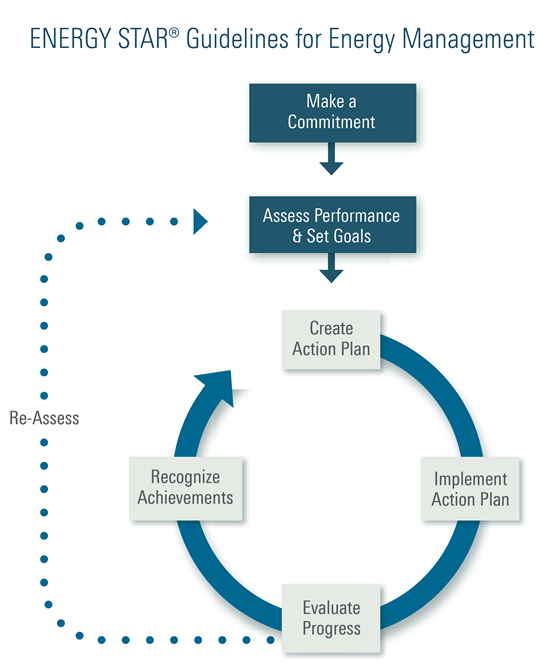Comprehensive Energy Management
The key to deep, sustained energy savings is comprehensive energy management – that is, embedding energy management as a fundamental principle in your organization’s culture and business operations. The strategy relies on a process of monitoring, controlling, and reducing an organization’s energy use. It typically involves securing a commitment from senior management and measuring and tracking energy use, identifying opportunities for improvement, taking action to save energy, and verifying savings.
By strategically managing your energy use, your organization can save energy, save money, and protect the environment by reducing your greenhouse gas emissions.
The ENERGY STAR Guidelines for Energy Management
The ENERGY STAR Guidelines for Energy Management provide a proven strategy for creating a comprehensive energy management program. Based on the successful practices of ENERGY STAR partners, these guidelines can help your organization plan and implement an energy management program that delivers deep, sustained energy savings over the long-term.
A 7-Step Road Map

The ENERGY STAR Guidelines contain a step-by-step road map for continuous improvement, based on best practices from the nation's leaders in energy management. The document is broken out into seven steps:
- Step 1: Make Commitment
- Step 2: Assess Performance
- Step 3: Set Goals
- Step 4: Create Action Plan
- Step 5: Implement Action Plan
- Step 6: Evaluate Progress
- Step 7: Recognize Achievements
Maximize your savings by downloading the ENERGY STAR Guidelines for Energy Management. Each step is facilitated by tools to help you take action.
Assess Your Current Energy Program
Through over a decade of observation and analysis, EPA has found that the most successful organizations are the ones that fully implement the practices outlined in the ENERGY STAR Guidelines for Energy Management. Comparing your program to the best practices outlined in the guidelines will help you identify strengths and weakness and your next steps to maximize savings.
EPA has two tools to help you assess the starting point of your current program:
- Use the Energy Program Assessment Matrix to see how your organization’s energy management program stacks up to industry best practices.
- Use the Facility Energy Assessment Matrix to assess how well an individual building is implementing your organization’s energy program.
Read more about the business case for improving efficiency and operating a high-performing portfolio of buildings, or check out the accomplishments of ENERGY STAR Award winners, the top organizations that are raising the bar and leading their industries.
